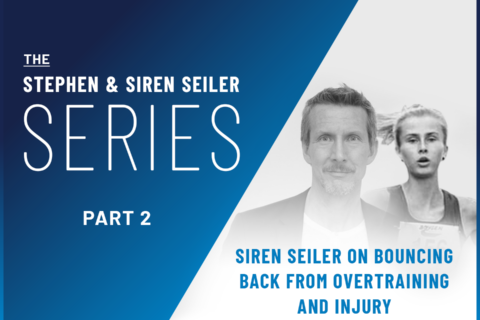Dr. Stephen Seiler explains why polarized training is a winning strategy for the long game of endurance sports. By balancing the stress of training, athletes see bigger gains over time.
Video Transcript
Polarized training has been around for a long time. But recently, it’s been getting a lot of attention. Here at Fast Talk Labs, we get a lot of questions about polarized training, and so we thought it would be best to sit down with the biggest name in polarized, Dr. Stephen Seiler. During this conversation, we talk about his inspiration to do the research, what polarized actually means, who can benefit, and finally, the nuts and bolts of how to polarize your training.
The Value of Polarizing Your Training
Why should anyone who cares about endurance training care about polarized training?
I think everybody who is an endurance athlete and they plan on having success, they got to have a long game. They’ve got to be thinking about how they can make this a sustainable process, because that’s how adaptations happen. They don’t happen overnight, and so then you have to have a strategy. That strategy, why the polarized training model seems to have evolved and emerged, is it is a strategy. It is a strategy for sustainability, it’s a strategy for progress. It’s a strategy for the long game. It creates an intensity distribution, that as a general rule provides guardrails for the athlete when negotiating the curves, and the steepness of training where things are tough, and it’s easy to make mistakes, it narrows the risk of big mistakes. You still have to guide yourself, but by getting this relationship between low intensity, longer sessions, and higher intensity sessions getting that relationship right, that ratio, it solves a lot of problems before they become problems. That’s what we’ve seen from 25 years of research now.
What Are We Really Polarizing?
What exactly is it that people ought to be polarizing? If we could just be really clear about that?
This is a really important question. To be honest, I’m kind of responsible for introducing that term, so I have to take responsibility for introducing a term that can be confused. It can create confusion, because then you have to say, well if you really take that term to its logical conclusion, then easy is just easier and easier and hard is harder and harder, and it’s more polarized. But that’s a misinterpretation, and that’s unfortunate.
What are we really polarizing? What we are trying to achieve is a polarization of the stress of the daily training sessions. That is to say that we have an intention on most days to achieve a training session without triggering a big stress response. So, we are trying to achieve signaling without big stress responses. However, we do need to do some training where the big stress responses are going to happen. It is that [stress] that we’re polarizing. That 2-hour easy, steady-state run or that 3-hour cycling session, where the athlete is able to just relax, they’re able to breathe easily, they’re able to talk with their their colleagues or their partners as they’re riding or running. They come to the dinner table after they’re done and they’re immediately hungry. They haven’t triggered that stress response, but they’ve gotten the work done, and they’ve gotten a lot of signaling. Then some days, those hill climb repeats or the tough threshold session. . . . It is tough, it’s mentally challenging, it’s physically challenging, it’s going to take longer to recover from, but it’s part of the training process. It has to pepper the total process. Well, those are those high-stress sessions, that’s what we’re polarizing.
A New Way to Think about Training Stress
Those high-stress sessions can take on different forms. That’s where confusion emerges, because then we can get into arguments:
- Is it a pyramidal model?
- Is it a polarized model?
- Is it threshold you’re doing?
- Is it zone 4?
- Is it zone 5?
When I first was quantifying this, I was very concerned about all of that. But it turns out, it doesn’t need to be so concerning because once you get above that [aerobic] threshold, the stress responses start to happen. You start to see the higher adrenaline responses, you start to see changes in heart rate variability, you start to see these classic signatures. So a hard threshold session, hard zone 4 session, super hard zone 5, it all goes in the same bucket. It’s a high-stress session, so that makes it more simple. That’s what we’re trying to polarize. But sometimes in the training season we may use more threshold work for those high-intensity sessions. Sometimes it may be more VO2max type sessions. But they’re falling into that same category that says, “When I do these [sessions], it will be tough, they will take longer to recover from.
The 3-Zone Model of Polarized Training
What constitutes low intensity in your model, in your observations?
In a polarized model, really, you can say that the first lactate threshold is maybe the most important dividing line. In a pure physiological model that we published in journals, we typically describe three zones:
Zone 1 is below that first lactate turn point.
Zone 2 is between the first and second lactate turn points, it’s in that threshold range.
It’s appropriate to think of threshold as a range of pace or power. For me, that range is like about 230 to 305-310 watts, somewhere in that range. If I’m on the easy side of it (on the low side of it), I’ll be going for a long time. If I’m on the higher side of it, it’ll be a shorter time.
Crossing that second divide, that second lactate turn point, puts us into that zone 3, and the upper end of that will be VO2max and heart rate max. Then of course, you can talk about intensity zones above VO2max, but that would be things like sprints and anaerobic, short 30-second efforts at full gas, and so forth.
The 5-Zone Model of Polarized Training
We tend to think about three zones. Now, for communication for a bit more nuance, a lot of federations and organizations will have more zones. They may have five zones, like we do in Norway for that aerobic range. So they take that zone 1 below the first turn point, and they give it a zone 1 and a zone 2 within that [range]. So green and dark green.
Then that zone 2, in the 3-zone model becomes zone 3. It’s yellow–now if we were gonna give it a color, it’s threshold, it’s warning: yellow, you’re encroaching. You’re starting to push the hard pressure on yourself.
Then finally, once we cross that divide, then we can take that zone 3, and divide it up and create a zone 4 and 5. You will see these overlapping, a 3-zone model and a 5-zone model. They’re anchored at the same place. They’re anchored by the same physiological markers, LT1 and LT2.
What Counts as a Hard Training Session?
We talked about low intensity being in those green zones in the Norwegian model below the first lactate turn point. When we talk about high intensity (the other end of the recommendation in the polarized model), is that the intensities that are above the second turn point that are in zone 3 of the 3-zone model? Or is there room to do a little bit of work below that second turn point, say at 95 percent of that turn point, is that valid as well in the polarized model?
Once you cross that first turn point, now you’re in that high-stress range. Now it depends on how hard you go, but I had one workout the other day where I was 2.5 hours at 260 watts. That was tough for me, and that was because I was in that threshold range for 2.5 hours. I felt that for two days. I was not able to, the next day feel just perfectly back to normal. But it wasn’t a really high-intensity session. However, the combination of a fairly high intensity and a long duration, the combined effect of those was a high-stress workout. Then, we’re back to what I was talking about: What are we polarizing? Stress and polarizing the expected stress of that session. And I knew this would be tough. I like to do occasionally these tough threshold sessions that are long and arduous, because I think, it helps prepare me for racing. But it’s I consider it high-stress, it’s a hard session. Even though heart rate was not 95 percent of max, I still put it in that hard session bucket in my accounting of my training.
It’s not just heart rate, or just lactate. I try to tell people, you cannot evaluate intensity in a vacuum–you have to look at intensity, and duration. Especially once you start getting into those higher-intensity ranges, threshold plus–the minutes matter. How long am I sustaining that intensity, because as the minutes increase the internal stress, the internal load of achieving that same external power is getting higher and higher. So, in my 2.5 hour workout, I broke it up into 30-minute sections. Then I looked at my heart rate, and my breathing frequency for each 30 minutes across what was a fairly even power output. But that combination was just slowly going up. In the last 30 minutes, it was really going up. My body was really starting to say, “Hey, it’s quitting time here, what are you doing?” That goes back to when we’re trying to quantify load or stress or whatever, then we have to be really careful what we’re talking about, external load versus internal.
Look to Optimize, Not Maximize Your Training
You’ve been doing this for a long time, this research started many, many years ago. What big changes in your thinking have occurred since the beginning of the research and until today?
I have gone from seeing the training process as a maximization problem, to seeing it as an optimization problem. That would be the basic [change], in a nutshell. At first I thought, well, maximize VO2max, maximize threshold power or pace, maximize efficiency, make them all as high as you can, and you’ll go faster. I’m just thinking on that one side of the equation, which is the the input and the physiological adaptations. But I was forgetting that along for the ride is stress, is inflammatory responses, immune suppression, reactive oxygen species, energy depletion, various kinds of problems up in the head, it’s autonomic nervous syst shifts, and so forth. A lot of systemic level stress and strain responses are happening as I try to maximize these adaptations in the muscle or in the heart or so forth. The big understanding, the big epiphany (it’s a slow epiphany, you might say), is seeing the training process as this holistic balance between signal and stress. Finding that balance, is individual, but these guardrails help. These intensity distribution guardrails help us to come into a sustainable, progressive, developmental process.
Sustainable I know is a tired word that we use too much, but it is really important for endurance athletes. It’s the correct way to think, if it’s not a sustainable training process, then you’re not going to get where you want to go. Endurance training takes time. You don’t create endurance champions in a year or six weeks. They build over years. It doesn’t matter which endurance sport we’re talking about. It does take time. Now we may see them pop up on the radar, and it looks like they’re coming out of nowhere, but behind that they’ve been doing the work for years. So if you’re into the endurance game, you need to be into the long game, and you need to be looking for a sustainable process.
Polarized training is a complex topic and this conversation with Dr. Seiler has only scratched the surface. We have much more information in our Polarized Pathway to help you fully understand and optimize your training.




